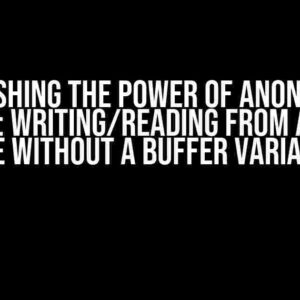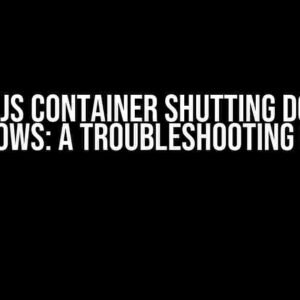Are you ready to dive into the world of decentralized finance and create your own mint NFTs on the Solana blockchain using Rust language? Look no further! In this comprehensive guide, we’ll take you by the hand and walk you through the process of creating, deploying, and minting NFTs on Solana using Rust.
What is Solana?
Solana is a fast, decentralized, and scalable blockchain platform that uses a novel consensus algorithm called Proof of History (PoH). It’s designed to support high-performance decentralized applications (dApps) and has gained popularity among developers and users alike.
What is Rust Language?
Rust is a systems programming language that’s gaining popularity due to its focus on security, performance, and conciseness. It’s being used in a wide range of applications, from operating systems to web browsers, and is particularly well-suited for building blockchain-related projects.
What are Mint NFTs?
Mint NFTs are unique digital assets that are created and stored on a blockchain. They can represent anything from art to collectibles, and their ownership is secured and verifiable through the blockchain. In the context of Solana, mint NFTs can be created and traded using the Solana CLI and Rust language.
Setting Up the Environment
Before we dive into the code, let’s set up the environment. You’ll need to install the following tools:
- Solana CLI: You can install it by running
sh -c "$(curl -sSf https://release.solana.com/v1.9.1/install)in your terminal. - Rust: You can install Rust using rustup by running
curl --proto '=https' --tlsv1.2 -sSf https://sh.rustup.rs | shin your terminal. - Cargo: Cargo is Rust’s package manager, and it comes bundled with Rust.
Creating a Solana Wallet
To interact with the Solana blockchain, you’ll need a Solana wallet. You can create a new wallet using the Solana CLI:
solana-keygen new
This will generate a new keypair in the ~/.config/solana/id.json file.
Creating a Rust Project
Let’s create a new Rust project using Cargo:
cargo new mint_nft --bin
This will create a new directory called
Installing Required Crates
We’ll need to install the following crates:
solan-sdk: This crate provides a Rust interface to the Solana blockchain.serde: This crate provides a serialization framework for Rust.
Add the following lines to your Cargo.toml file:
[dependencies]
solan-sdk = "1.9.1"
serde = { version = "1.0", features = ["derive"] }
Implementing the Mint NFT Logic
Now that we have our project set up, let’s implement the mint NFT logic. We’ll create a new file called mint.rs in the src directory:
// src/mint.rs
use solan_sdk::_client::rpc_client::RpcClient;
use solan_sdk::program::program::Program;
use solan_sdk::system_instruction::SystemInstruction;
use solan_sdk::transaction::Transaction;
use serde::{Serialize, Deserialize};
#[derive(Serialize, Deserialize)]
struct MintNFT {
name: String,
symbol: String,
uri: String,
}
fn main() {
let rpc_client = RpcClient::new("https://api.devnet.solana.com");
let Program { program_id, .. } = Program::new("my_nft_program", &rpc_client);
let mint_nft = MintNFT {
name: "My NFT".to_string(),
symbol: "MNFT".to_string(),
uri: "https://example.com/mynft.json".to_string(),
};
let account = rpc_client.get_account(&program_id).unwrap();
let system_instruction = SystemInstruction::create_account(rpc_client.get_account_info(&account pub_key).unwrap().lamports, program_id, &account);
let transaction = Transaction::new_signed_with_payer(
&[system_instruction],
Some(&account.pub_key()),
&rpc_client.get_recent_blockhash().unwrap(),
program_id,
);
rpc_client.send_and_confirm_transaction(transaction).unwrap();
}
This code creates a new Solana program, defines a MintNFT struct, and uses the Solana SDK to create a new account and mint an NFT.
Deploying the Program
To deploy the program to the Solana blockchain, we’ll need to compile it and upload it to a Solana cluster:
cargo build --release
This will compile the program and generate a mint_nft executable.
solana program deploy target/release/mint_nft
This will deploy the program to the Solana cluster.
Minting the NFT
Now that the program is deployed, we can mint the NFT:
solana program invoke -v --program-idmint
Replace
Viewing the NFT
To view the minted NFT, we can use the Solana CLI:
solana nft get
Replace
| Property | Value |
|---|---|
| Name | My NFT |
| Symbol | MNFT |
| URI | https://example.com/mynft.json |
Congratulations! You’ve successfully minted an NFT on the Solana blockchain using Rust language.
Conclusion
In this article, we’ve covered the process of creating, deploying, and minting NFTs on the Solana blockchain using Rust language. We’ve set up the environment, created a Solana wallet, implemented the mint NFT logic, deployed the program, and minted an NFT.
Rust language provides a unique combination of security, performance, and conciseness that makes it an ideal choice for building blockchain-related projects. By following this guide, you can unlock the power of Solana and create your own unique NFTs.
Remember to stay tuned for more articles on blockchain development and Rust language. Happy coding!
Frequently Asked Questions
Get ready to dive into the world of Mint NFT on Solana using Rust language! We’ve got the answers to your burning questions.
What is Mint NFT on Solana, and how does it work with Rust?
Mint NFT on Solana is a decentralized application that allows creators to mint unique digital assets, called non-fungible tokens (NFTs), on the Solana blockchain. By leveraging Rust, developers can build fast, secure, and reliable NFT minting applications that interact with the Solana network. Rust’s memory safety features and performance capabilities make it an ideal choice for building high-performance NFT applications.
What are the benefits of using Rust for building Mint NFT on Solana?
Rust provides several benefits for building Mint NFT on Solana, including memory safety, performance, and reliability. Rust’s ownership model and borrow checker ensure that your code is free from common errors, making it ideal for building secure and reliable NFT applications. Additionally, Rust’s performance capabilities allow for fast transaction processing and high-throughput, making it perfect for building scalable NFT minting applications.
How does Rust’s syntax and ecosystem support NFT development on Solana?
Rust’s syntax is designed to make NFT development on Solana efficient and enjoyable. Rust’s concise syntax and expressive type system allow developers to write clean, readable code that’s easy to maintain. Additionally, Rust’s ecosystem provides a rich set of libraries and frameworks, such as Solana’s Rust SDK, that make it easy to interact with the Solana network and build NFT-specific functionality.
Can I use Rust to create custom NFT marketplaces on Solana?
Yes, absolutely! Rust provides a powerful foundation for building custom NFT marketplaces on Solana. By leveraging Rust’s performance capabilities and Solana’s decentralized architecture, you can create high-performance NFT marketplaces that support unique features, such as customized auctions, decentralized governance, and more.
What are some popular use cases for Mint NFT on Solana using Rust?
Some popular use cases for Mint NFT on Solana using Rust include gaming, art, collectibles, and decentralized finance (DeFi) applications. Rust’s performance capabilities and Solana’s fast transaction processing make it ideal for building high-performance NFT applications that support complex use cases, such as real-time gaming and high-frequency trading.



